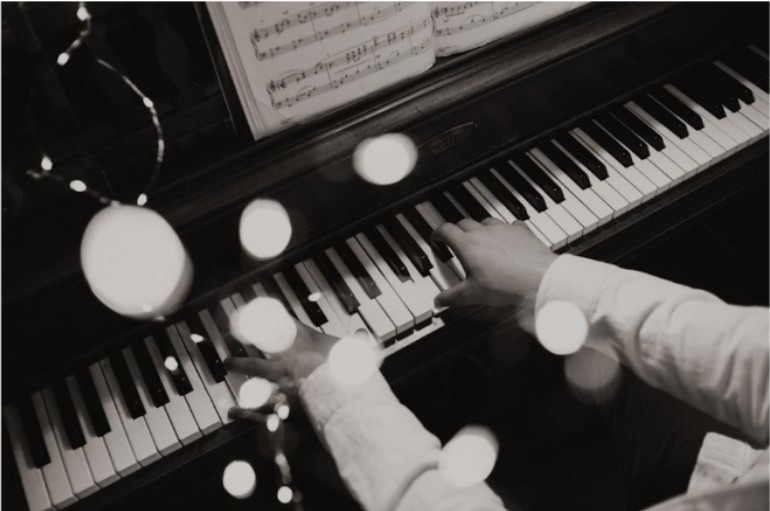For beginners who are just starting to learn how to play the piano, this can be highly intimidating; however, by means of structured teaching and unfaltering practice, one can master the art of a lifetime.
This exciting post discusses the main elements required for the proper sitting position, such as hand placement, sheet music reading, mastering rhythm and technique, understanding theory, creating a good practice plan, expanding repertoire, and adopting a growth mindset.
If you are committed to changing from an amateur to an accomplished player, follow these guidelines. This brief guide will get you started on the road to success at the piano, whether you are just playing your favorite tunes or aspiring to conquer the concert stage with your virtuosic classical skills.
Table of Contents
ToggleProper Posture and Hand Positioni

Proper posture and hand position are the foundation for learning how to play piano well. Maintaining proper posture is crucial in preventing injury and mastering piano technique.
When sitting at a piano bench, your back must be straight but relaxed with shoulders down to align with the keys. Make sure your forearms are parallel with a flat bench surface. Additionally, make sure your wrists are level with your knuckles, avoiding any upward or downward bending.
Create a smooth and captivating hand position by gently curving your fingers and allowing them to remain supple. Avoid overreach by keeping your fingers close to the black keys. Strive for firmness in your fingertips without restricting their natural flexibility.
Significantly, to ensure fluid movement, maintain some space between your fingers. Achieve a well-balanced hand shape by placing your thumbs behind the second digit knuckle.
Reading Sheet Music
Reading a music sheet is not only an added skill but also a gateway to effortlessly playing various piano pieces.
The treble and bass clefs contain different pitches, with higher notes appearing in the treble clef while lower notes are shown in the bass clef. This system clearly shows where the notes lie on the staff, giving us an exact understanding of the pitch. Its essential purpose is to ensure that we play music correctly regarding pitch.
Furthermore, vocal notes are distinguished by sharp and flat signs, which increase the complexity and intricacy of the composition. The inclusion of time signatures such as 4/4, vital for establishing rhythm in a piece, as well as discreet bar lines separating each measure, contributes subtly to the intended comic effect.
In addition, key signatures are carefully chosen for smooth modulation from dominant or tonic keys, thus giving the music a sense of stable tonality. However, these elements do bring a composition alive.
Understanding Rhythm

The significance of rhythm in music must be noticed, for it gives a piece its tempo and momentum. Vertical lines on a musical staff serve as the foundation for rhythm, helping to identify each note’s unique beat. Each note has a specific duration, with whole notes equaling 4 beats, half notes equal to 2, and quarter notes amounting to one. Dotted notes extend the length of a note, while pauses show when there is silence.
To become an excellent conductor, you must analyze tempo critically by making its beat felt and dividing it accurately. Use rhythm and vocalization, in which case the legs will lead first. Start with basic rhythm patterns before trying more complex ones as your coordination improves. This inclusive procedure leads to a better understanding of rhythm that enhances accuracy and skillfulness in conducting performances.
Music Theory Basics

Keyboards open up an immense new world to musicians who study music theory. The conventional arrangement of white keys from A-G in repeating octaves only scratches the surface. Nonetheless, adding black keys, sometimes referred to as sharps and flats, gives a different perspective that enhances its impact entirely.
In addition, when played with our fingertips, these pieces show tales of sorrow and misery but also talk about times full of happiness and life. Also, understanding scales or modes and key signatures that can either be changed through or preserved while having complex arrangements on notes enriches our grasp on the instrument even more.
Music extends beyond singing beautifully. Essential components include developing chords based on stacking thirds, understanding intervals, and getting depth or dimension out of various tones. In this one momentous instant, all these constituents meet in harmony together.
This helps to create an uninterrupted smooth flow for music complemented by gradual progression due to time signs and beat marks while illustrating how exercises sustain continuous momentum. These fundamental elements allow for a deeply emotional connection to the music and facilitate necessary aspects such as analysis, interpretation, and comprehension for a genuinely satisfying musical experience.
Effective Practice Tech

Nothing is more important than never giving up and doing piano practice daily if one wants to be a great pianist, which means dedicating at least thirty minutes every day as part of an overall strategy for living.
Design specific exercise routines targeting various aspects of playing, e.g., scales, arpeggios, and finger exercises, to improve your skills. By going through these workouts, this will enable you to shape your physique and mind according to performance demands. Be gentle as you try out new musicals.
As you go along, in addition to continually increasing speed with growing confidence over time, keep in mind that they can be overcome through separate hand practices and personal confrontations. It may be moderate, but everything will fall while crossing over each hurdle in the music journey so long as there is eagerness and perseverance.
Conclusion
Playing on the piano fulfills any musician. Hard work pays off because just imagining being able to make audible sounds using your fingers provides gratification, even though it requires determination and relentlessness.
Dive right into this beginners’ guide addressing posture, technique, sight reading, music theory, and how to practice all these things effectively. With this comprehensive resource, you’ll be well on your way to mastering the piano in a short amount of time. So, let your passion fuel your determination and unlock the enchanting world of piano playing.
More Stories
How Pack Mule Dumpsters is Changing the Game in Springboro’s Waste Disposal
Springboro residents, rejoice! There's a new player in town revolutionizing the way we handle waste disposal, and its name is...
Riding the wave_of_happy: Understanding the Psychology of Happiness
Wave_of_happy a word that carries immense weight in our lives. We all strive for it, pursue it relentlessly, yet it...
The Rise of Eco-Friendly Hair Care: What You Need to Know
In excellence and individual care, the tide is unmistakably turning towards maintainability. As customers become progressively aware of their natural...
Rejuvenating Cream: Your Shield Against Pigmentation
Dealing with pigmentation can be a daunting task for many individuals, irrespective of age or skin type. Finding an effective...
Unlocking the Secrets of Hemp Seed Oil: Benefits, Uses, and Misconceptions
One product has consistently gained recognition and acclaim in the dynamic realm of natural health and wellness due to its...
Why Your Wedding Photographer Matters: Choosing the Right One for You
Your wedding day is a tapestry of cherished moments, woven together by love, laughter, and the promise of forever. Amidst...



